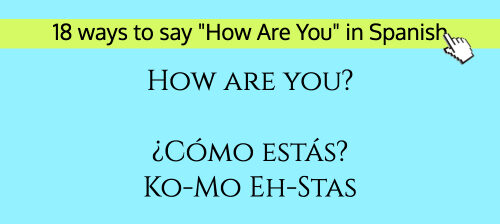The Basic Phrase: “¿Cómo estás?”
The most common way to say How Are You in Spanish is “¿Cómo estás?”
Usage
This phrase is informal and widely used among friends, family, and peers. It conveys a sense of warmth and familiarity, making it an excellent choice for casual conversations. Whether you’re meeting someone new or catching up with a friend, “¿Cómo estás?” is a friendly opener.
Pronunciation
To pronounce “¿Cómo estás?”, break it down like this:
- ¿Cómo – Pronounced as “koh-moh”
- estás – Pronounced as “es-tahs”
Examples in Context
- Meeting a Friend:
You see a friend at a café:
You: “¡Hola! ¿Cómo estás?”
Friend: “¡Muy bien, gracias! ¿Y tú?” - Starting a Conversation:
You’re at a party and approach someone you know:
You: “¡Hey! ¿Cómo estás?”
Person: “Bien, ¿y tú?”
Formal Variation: “¿Cómo está usted?”
In more formal situations, such as when speaking to a stranger, an elder, or in a professional setting, you would use “¿Cómo está usted?”
Usage
This phrase demonstrates respect and is suitable for formal introductions or professional contexts. It’s a crucial phrase to remember, especially when you want to make a good impression.
Pronunciation
The pronunciation for “¿Cómo está usted?” is as follows:
- ¿Cómo – Pronounced as “koh-moh”
- está – Pronounced as “es-tah”
- usted – Pronounced as “oos-tehd”
Examples in Context
- Meeting a New Colleague:
You’re introduced to a new colleague:
You: “Hola, ¿cómo está usted?”
Colleague: “Muy bien, gracias. Encantado de conocerlo.” - Speaking to an Elder:
You meet someone’s grandparents:
You: “Hola, ¿cómo está usted?”
Grandparent: “Gracias, muy bien. ¿Y tú?”
Alternative Informal Greetings
In addition to “¿Cómo estás?”, there are several other informal greetings you can use to add variety to your conversations.
1. “¿Qué tal?”
This phrase translates to “What’s up?” and is commonly used among friends. It’s a casual way to ask how someone is doing without being too formal.
- Usage: Ideal for informal settings.
- Pronunciation: Pronounced as “keh tahl”
Example in Context
At a gathering, you approach a group of friends:
You: “¡Hola! ¿Qué tal?”
Friend: “¡Todo bien! ¿Y tú?”
2. “¿Cómo te va?”
This translates to “How’s it going?” and is another friendly option.
- Usage: Suitable for acquaintances and friends.
- Pronunciation: Pronounced as “koh-moh tay vah”
Example in Context
You run into a neighbor:
You: “¡Hola! ¿Cómo te va?”
Neighbor: “Bien, gracias. ¿Y tú?”
3. “¿Qué pasa?”
Commonly used in Spain, this phrase means “What’s happening?”
- Usage: Informal and often used among younger people.
- Pronunciation: Pronounced as “keh pah-sah”
Example in Context
You see a friend at school:
You: “¡Hey! ¿Qué pasa?”
Friend: “Nada, solo estudiando.”
Responses to “¿Cómo estás?”
Knowing how to respond is just as important as asking. Here are some common responses to use when someone asks you how you are:
1. “Estoy bien.”
This translates to “I’m good.” It’s a simple and straightforward response.
2. “Más o menos.”
This means “So-so.” Use this when you’re feeling neither great nor terrible.
3. “No muy bien.”
Meaning “Not very well,” this is an honest response when you’re not feeling your best.
Examples in Context
- Friend Asks:
Friend: “¿Cómo estás?”
You: “Estoy bien, gracias.” - Casual Conversation:
Friend: “¿Qué tal?”
You: “Más o menos, he tenido una semana difícil.” - Checking In:
Friend: “¿Cómo te va?”
You: “No muy bien, estoy un poco estresado.”
Regional Variations
Spanish is a diverse language spoken in many countries, and the phrases can vary regionally. Here are a few variations you might encounter:
1. Mexico
In Mexico, you might hear “¿Qué onda?” which translates to “What’s up?” This is a very casual and common greeting among younger people.
2. Spain
In Spain, “¿Qué pasa?” is frequently used. This greeting is often accompanied by a casual tone and is popular among friends.
3. Argentina
In Argentina, people may say “¿Todo bien?” meaning “Everything good?” This reflects a friendly, informal approach.
Example in Context
In a Mexican context:
You: “¡Hola! ¿Qué onda?”
Friend: “¡Nada, todo bien!”
In an Argentinian context:
You: “¡Hola! ¿Todo bien?”
Friend: “Todo perfecto.”
Cultural Insights
Understanding the cultural context behind greetings can enhance your interactions with Spanish speakers. In many Spanish-speaking cultures, greetings are more than just a formality; they are a way to establish connection and show respect.
Importance of Greeting
In Latin American and Spanish cultures, taking the time to greet someone and ask how they are can convey warmth and friendliness. It’s common to greet people you encounter throughout the day, whether at work, in a shop, or on the street.
Physical Gestures
In addition to verbal greetings, many Spanish speakers may greet with a handshake, hug, or kiss on the cheek, depending on the level of familiarity and cultural norms. Being aware of these customs can help you navigate social situations more smoothly.
Conclusion
Mastering the phrase How Are You in Spanish is a fantastic starting point for your language learning journey. Whether you opt for “¿Cómo estás?”, “¿Cómo está usted?”, or any of the other variations, you’ll find that these greetings open the door to richer conversations and relationships.
As you practice, remember to pay attention to the context, choose the appropriate level of formality, and embrace the cultural nuances that come with speaking Spanish. With these tools in hand, you’ll be well on your way to connecting with Spanish speakers and enjoying the beauty of the language.
Happy learning, and don’t hesitate to practice these phrases in your daily life! The more you use them, the more comfortable you’ll become.





